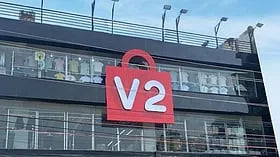
V2 Retail’s Remarkable Turnaround: How Ram Chandra Agarwal Rebuilt a Retail Empire from Bankruptcy
Table of Contents
- Key Highlights:
- Introduction
- The Rise and Fall: A Cautionary Tale
- V2 Retail: A New Business Model
- Future Growth Strategy: FY26–30 Playbook
- Valuation Insights: A Competitive Edge
- The Significance of V2 Retail’s Comeback
- FAQ
Key Highlights:
- Ram Chandra Agarwal, founder of V2 Retail, has successfully transformed the company from bankruptcy to a market capitalization of Rs 6,500 crore, delivering over 3,200% returns to shareholders in five years.
- After the failure of his first venture, Vishal Mega Mart, Agarwal restructured his business model focusing on private-label products and strategic store placements, resulting in significant revenue growth and profitability.
- V2 Retail plans to expand aggressively, aiming to open 100 new stores annually while maintaining financial discipline and minimizing debt.
Introduction
In the world of retail, resilience and adaptability are crucial for success. Few exemplify this better than Ram Chandra Agarwal, whose journey from bankruptcy to rebuilding a thriving retail chain is not just a personal triumph but a compelling narrative about the evolution of organized retail in India. His story, characterized by innovation, strategic planning, and a keen market understanding, culminates in the establishment of V2 Retail, a brand that has become synonymous with value-driven fashion in smaller cities. With plans for aggressive expansion and a commitment to internal funding, Agarwal’s journey serves as a case study for entrepreneurs and investors alike.
The Rise and Fall: A Cautionary Tale
Agarwal's initial foray into the retail world began with Vishal Mega Mart, which he founded in 2001. Starting with a single outlet in Delhi, the brand quickly expanded to 170 stores, becoming a household name in Indian retail. By 2007, Vishal Mega Mart had gone public, raising Rs 110 crore through its initial public offering. However, the rapid expansion came at a cost. The financial crisis of 2008 exacerbated the company's vulnerabilities, leading to over-leverage and ultimately a distress sale to TPG and the Shriram Group in 2011 for a mere Rs 70 crore.
This experience could have marked the end of Agarwal's career; instead, it became the catalyst for his resurgence. Learning from the pitfalls of his past, he launched V2 Retail in 2011 with a different approach—one that emphasized tighter working capital cycles and a significant focus on private-label products. This strategic pivot allowed V2 Retail to thrive in a competitive market.
V2 Retail: A New Business Model
V2 Retail's business model is distinct from its predecessor, emphasizing efficiency and brand strength. The company has adopted a cluster approach, strategically locating 60–70% of new stores in areas with high brand recall, which has proven crucial for customer retention and market penetration. As of now, V2 Retail operates 189 stores across 20 states, covering a retail area of 20 lakh square feet—a significant feat considering its humble beginnings.
A noteworthy aspect of V2 Retail's strategy is its substantial reliance on private-label products, which constitute 85% of its offerings. This not only enhances profit margins but also builds brand loyalty among consumers who value quality at competitive prices. Akash Agarwal, the next generation in the family business, reported that the company’s performance has been stellar, with revenues rising 62% year-on-year and profits increasing 2.6 times. The financial health of V2 Retail is underscored by a robust cash flow, with operational cash flow standing at 89% of EBITDA.
Future Growth Strategy: FY26–30 Playbook
With a strong foundation, V2 Retail is setting ambitious targets for the future. Akash Agarwal revealed plans to open 100 new stores in the ongoing financial year, a move that reflects confidence in the brand's growth trajectory. The entire capital expenditure for these new outlets will be funded through internal accruals, signaling a commitment to financial prudence and sustainability. The company's previous guidance remains unchanged, predicting a top-line growth of 45–50% for FY26-27, alongside a same-store sales growth of 8–10% as new stores mature.
The company has also outlined its expectations for EBITDA margin expansion and a profit after tax (PAT) margin of 4-5%. New stores are expected to break even at Rs 500 per square foot, generating revenues of Rs 750–800 per square foot. The anticipated payback period for these new stores is projected at four years, ensuring a measured approach to expansion.
Valuation Insights: A Competitive Edge
As V2 Retail continues to expand, its valuation has garnered attention. Currently, the company holds a market capitalization of around Rs 6,500 crore, trading at approximately 20 times projected FY27 earnings. This valuation surpasses that of its competitor, V-Mart, yet remains lower than several lifestyle retail peers. Financial analysts have expressed optimism, with two brokerages rating V2 Retail stock as a "Buy" and projecting a 55% upside, driven by scale benefits and higher gross margins from private labels.
The firm’s current gross margins are between 35-40%, with targets to reach 60% by summer 2026. This growth in margin is anticipated even amidst potential fluctuations in discretionary spending, showcasing V2 Retail's strategic advantage in the market.
The Significance of V2 Retail’s Comeback
Agarwal's comeback story is emblematic of a broader transformation in the Indian retail landscape. As V2 Retail carves a niche in value fashion, particularly in smaller cities, it reflects changing consumer preferences and a growing market for organized retail. The company’s disciplined approach to capital management and its focus on leveraging private-label products have positioned it well for sustained growth.
Investors and analysts are closely monitoring V2 Retail's performance, particularly its ability to maintain growth rates exceeding 45% without resorting to additional leverage. The company's robust financial performance, combined with an aggressive expansion strategy, paints a promising picture for its future.
FAQ
What led to the bankruptcy of Vishal Mega Mart? The bankruptcy of Vishal Mega Mart was primarily due to over-leveraged expansion and the impact of the 2008 financial crisis, which forced a distress sale to TPG and the Shriram Group in 2011.
How has V2 Retail managed to grow so rapidly? V2 Retail has focused on a business model that emphasizes private-label products, strategic store placements, and financial discipline, which has allowed for significant revenue and profit growth.
What are the future expansion plans for V2 Retail? V2 Retail plans to open 100 new stores annually over the next few years, aiming to reach 600-700 stores by FY30, all funded through internal accruals.
How does V2 Retail's valuation compare to its competitors? V2 Retail trades at a market capitalization of Rs 6,500 crore, with a valuation of about 20 times projected FY27 earnings, which is higher than V-Mart but lower than some lifestyle retail competitors.
Why is V2 Retail's comeback significant? The comeback of V2 Retail underlines a shift in organized retail in India, showcasing how strategic management and a focus on value can yield high returns, especially in smaller markets.
POWER your ecommerce with our weekly insights and updates!
Stay aligned on what's happening in the commerce world
Email Address
Handpicked for You

08 September 2025 / Blog
How to Avoid Greenwashing: Rules, Real-World Examples, and a Practical Playbook for Honest Environmental Claims
Read more
08 September 2025 / Blog
Klaviyo 2025: How its AI-Driven CRM Transforms Shopify Email Marketing and the Customer Experience
Read more
08 September 2025 / Blog


